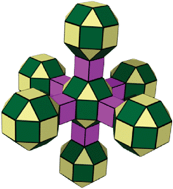This critical review highlights supermolecular building blocks (SBBs) in the context of their impact upon the design, synthesis, and structure of metal–organic materials (MOMs). MOMs, also known as coordination polymers, hybrid inorganic–organic materials, and metal–organic frameworks, represent an emerging class of materials that have attracted the imagination of solid-state chemists because MOMs combine unprecedented levels of porosity with a range of other functional properties that occur through the metal moiety and/or the organic ligand. First generation MOMs exploited the geometry of metal ions or secondary building units (SBUs), small metal clusters that mimic polygons, for the generation of MOMs. In this critical review we examine the recent (<5 years) adoption of much larger scale metal–organic polyhedra (MOPs) as SBBs for the construction of MOMs by highlighting how the large size and high symmetry of such SBBs can afford improved control over the topology of the resulting MOM and a new level of scale to the resulting framework (204 references).

You have access to this article
 Please wait while we load your content...
Something went wrong. Try again?
Please wait while we load your content...
Something went wrong. Try again?


 Please wait while we load your content...
Please wait while we load your content...